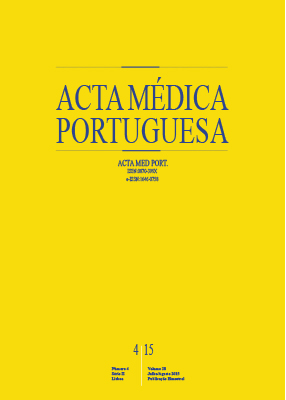Mumps Outbreak among Highly Vaccinated Teenagers and Children in the Central Region of Portugal, 2012-2013
DOI:
https://doi.org/10.20344/amp.5756Keywords:
Adolescent, Child, Disease Outbreaks, Measles-Mumps-Rubella Vaccine, Mumps, Portugal.Abstract
Introduction: Mumps vaccine was introduced in the National Immunization Program in Portugal in 1987, rapidly reaching a national coverage > 92%, with important reduction in the annual incidence of the disease. We report a mumps outbreak in the Central Region of Portugal, occurred in the winter 2012-13.
Material and Methods: Cases of salivary-gland swelling and other symptoms compatible with mumps were investigated. Geodemographics, clinical, laboratory and vaccination data were analyzed.
Results: Over six months, 148 outbreak-related cases were reported: 87.8% occurred in three of the 16 affected counties and 78.4% had a known epidemiological link. Median age was 14.5 years (2-62) and 70.3% were 11-20 years old; 61.5% were male. The mean duration of disease was seven days (2-20). The disease was generally mild; 80.4% had fever and in 55.4% there was unilateral involvement of the parotid gland. Seven cases had orchitis, one oophoritis and one had nephritis. Two cases were hospitalized. School transmission predominated and class attack rates were < 30%. Most of the cases occurred in vaccinated individuals (92%) of whom 86.8% had received 2 doses; 17.7% had received one dose of the vaccine containing the Rubini strain. Mumps virus genotype G was identified in 4 cases.
Discussion: This mumps outbreak among a highly vaccinated population, occurring mostly in teenagers at school, could be due to the partial effectiveness of the vaccine against the disease (particularly in the group vaccinated with Rubini strain), waning immunity overtime and genotype mismatch.
Conclusions: This outbreak report shows the importance of discussion about the need of more booster dose of the actual vaccine or new vaccine including more genotypes to improve immunogenicity.
Downloads
Downloads
Published
How to Cite
Issue
Section
License
All the articles published in the AMP are open access and comply with the requirements of funding agencies or academic institutions. The AMP is governed by the terms of the Creative Commons ‘Attribution – Non-Commercial Use - (CC-BY-NC)’ license, regarding the use by third parties.
It is the author’s responsibility to obtain approval for the reproduction of figures, tables, etc. from other publications.
Upon acceptance of an article for publication, the authors will be asked to complete the ICMJE “Copyright Liability and Copyright Sharing Statement “(http://www.actamedicaportuguesa.com/info/AMP-NormasPublicacao.pdf) and the “Declaration of Potential Conflicts of Interest” (http:// www.icmje.org/conflicts-of-interest). An e-mail will be sent to the corresponding author to acknowledge receipt of the manuscript.
After publication, the authors are authorised to make their articles available in repositories of their institutions of origin, as long as they always mention where they were published and according to the Creative Commons license.









